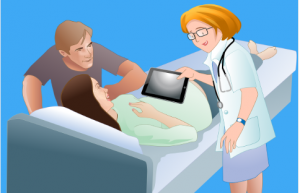No one ever wants to have to go to an urgent care center, but unfortunately, sometimes it’s unavoidable. If you take a fall and your ankle swells up or you spike a fever and can’t wait for an appointment with your primary care doctor, it’s better to seek treatment at an urgent care center than ignore your symptoms. In fact, urgent care centers handle approximately 89 million patient visits each year in the United States, according to the Urgent Care Association (UCA). Of course, it can be confusing to know where the best place to seek treatment might be. Fortunately, urgent care is usually the best place to go for unexpected medical problems.
Urgent Care vs. Emergency Room
“Urgent” and “Emergency” have very similar meanings, so it’s completely understandable that people might be unsure which place they are supposed to go to in the throes of an unexpected medical situation. However, there is a distinct difference between the two types of medical care, and it’s important to know the difference.
An urgent care center is used for patients who might not have health insurance or people who have sudden, non-life-threatening medical conditions that require treatment within 24 hours. These are places where you would go if you have an unexpected or sudden condition that you want to seek medical treatment for but you are not experiencing anything life-threatening. They are designed to treat minor illnesses or injuries, and most people end up there because their normal doctor’s office is not open or available. As of 2023, there are over 10,000 urgent care centers across the United States, reflecting a significant growth in recent years.
Emergency rooms are open all hours and are equipped to handle medical emergencies that are serious or critical. These are places where you might go if you have a serious injury that might require stitches, serious burns, or symptoms that could indicate a life-threatening condition. According to the Centers for Disease Control and Prevention (CDC), there were over 130 million emergency room visits in the U.S. in 2021. And it’s better safe than sorry—if you’re seriously questioning your symptoms and you’re worried that they might indicate something serious, the emergency room should be your next stop. They are staffed with professionals who can evaluate your symptoms and provide you with the care you need. It’s better to be told that you have nothing to worry about by a healthcare professional than minimize your symptoms, go to urgent care, and end up in a dangerous situation where you don’t get the help you need in time.
What’s Behind the Growth of Urgent Care Clinics?
There are two factors contributing to the growth of urgent care clinics, according to Medical Economics. One is that working in urgent care allows physicians to have a better work-life balance than when they run their own practices. More and more often, doctors are opting to work full-time in urgent care clinics rather than run their own practices and sacrifice valuable time with their families. In fact, employment in urgent care centers has increased by 9% annually since 2013, offering more flexible schedules for healthcare providers.
Additionally, urgent care clinics offer same-day treatment that often isn’t available through doctor’s offices. According to a 2022 survey by the UCA, 97% of urgent care patients reported being seen within 30 minutes, and 92% expressed satisfaction with their care. People are impatient and don’t want to wait for help—understandably—so often, people will choose to go to urgent care clinics rather than call and try to get an appointment with their primary care physician, which can sometimes take days or even weeks.
Pros and Cons of Urgent Care Clinics
Urgent care clinics are a critical part of the healthcare system. While regular check-ups are important preventative care, life happens! Sometimes you need to go to the doctor unexpectedly. However, urgent care visits shouldn’t replace your primary care doctor permanently. There are pros and cons to urgent care clinics, as there are with anything else.
Pros:
- Accessibility for All: Anyone can walk in and be seen, even without healthcare insurance. According to the UCA, 22% of patients who visit urgent care centers are uninsured, highlighting their accessibility.
- Extended Hours: Urgent care centers have extended hours. While not all are open 24 hours, 85% are open seven days a week, and many offer services beyond typical office hours.
- Shorter Wait Times: There is a lower wait time than in emergency rooms. The average wait time in an emergency room is about 2 hours, whereas 80% of patients at urgent care centers are seen within 15 minutes.
- On-Site Diagnostics: X-rays and lab testing are available. Many urgent care centers offer on-site diagnostics, with 70% providing X-ray services and 95% offering lab services.
Cons:
- Limited Time with Providers: Doctors don’t spend as much time with their patients in urgent care. Due to the high patient volume, visits can be brief, averaging about 15 minutes.
- Lack of Medical History Access: Your medical history won’t be available to the physician treating you. Without access to your full medical records, there might be gaps in care.
- Variable Staffing: Going to urgent care does not guarantee that you will see a doctor. You might see a physician assistant or nurse practitioner. According to the UCA, 13% of urgent care clinics are staffed solely by non-physician providers.
Mistakes to Avoid When Going to an Urgent Care Clinic
If you need to go to an urgent care clinic, there are a few things you should keep in mind.
- Know What It Will Cost: While this hopefully will not prevent you from getting the care you need, there is typically a cost of going to urgent care, even if you have insurance. The average cost of an urgent care visit is around $150, whereas an emergency room visit can average over $1,300, according to a 2020 study by UnitedHealthcare. Particularly if you have a PPO health insurance plan, urgent care visits will likely have a higher copay than a standard doctor’s visit. However, they are still usually lower than the cost of going to the emergency room. Regardless, it’s good to be aware of what kind of cost you’re going to be looking at after a visit to the urgent care clinic.
- Double-Check the Billing: Double-check that the urgent care center is actually urgent care. Some centers are billed like emergency rooms because they have an affiliation with a hospital. Before you sign in or consent to treatment, ask an employee if they bill like an urgent care center or an emergency room and make sure to get their name. If they bill like an emergency room, you might want to seek treatment elsewhere. Additionally, if you are billed as though you had an emergency room visit rather than an urgent care visit, you’ll be able to contest the charge if you can provide the employee’s name who told you differently.
- Bring Your Information: Keep in mind that if you’re going to an urgent care center, your medical records will not be available. Make sure to bring any documentation or information you need to seek treatment or provide context for your symptoms.
No one ever wants to need to go to urgent care, but in the event that something unexpected happens, it’s better to have the option to go somewhere for quick and effective treatment. And in the midst of an unexpected medical problem, you don’t want to be wondering where to go or what to do. Being prepared and understanding the difference between emergency rooms and urgent care means you’ll be able to handle the situation effectively and get the medical care that meets your needs.
If you operate an Urgent Care Center and need help with accounts receivables, then contact a Collection Agency.



